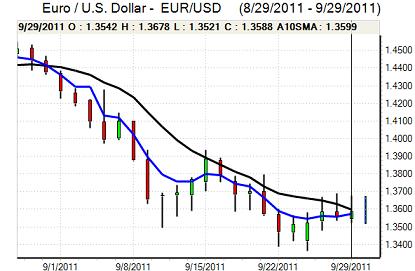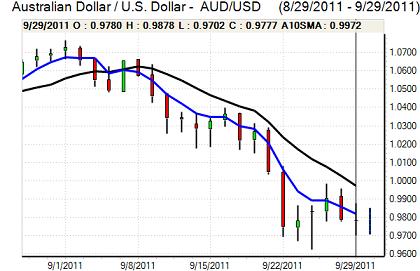EUR/USD
The Euro found support below 1.36 against the dollar during Thursday and maintained a generally firm tone even though it was difficult to break resistance levels in the 1.37 region.
The German parliament approved legislation to give the EFSF more powers with a strong majority support as total dissenters were kept to below 90. There was no real doubt surrounding the result given that the main opposition party had pledged to support the measure, but there was considerable uncertainty whether Merkel would be able to secure a majority within the governing coalition. In the event, there were 315 yes votes from the coalition compared with the 311 needed for a majority.
There was certainly relief that the vote had been passed and Merkel’s government is also safe in the short term, but there will still be a high degree of unease over the situation, especially as it will be even more difficult to secure majority support for further legislation in the future.
Markets will also focus on six other countries where the EFSF legislation has yet to be ratified. There were no major developments surrounding Greece during the day as the troika resumed its meetings and the Cabinet is due to meet on Sunday to discuss further austerity measures.
The latest US jobless claims was better than expected with a decline to 391,000 in the latest week from 428,000 previously and this was only the second reading below 400,000 since April. The latest GDP revision was also slightly better than expected which improved risk conditions slightly.
The US dollar failed to gain support from the data as risk appetite improved and the Euro gained some support from an underlying improvement in risk appetite as banking-sector stocks continued to rally.

Source: VantagePoint Intermarket Analysis Software
Call now and you will be provided with FREE recent forecasts
that are up to 86% accurate * 800-732-5407
If you would rather have the recent forecasts sent to you, please go here
Yen
The dollar found further support on dips to the 76.30 area on Thursday and rallied sharply to highs close to 77 during New York trading. The US currency gained some degree of support from the firmer than expected labour-market data, although the shift in yields was still limited. There was month-end positioning which triggered additional volatility in the pair.
There was a general improvement in risk appetite which curbed demand for the Japanese currency to some extent after the German vote.
Markets also remained sensitive to the potential threat of intervention, especially as the Finance Ministry has been notably quiet over the past week.
Sterling
Sterling was subjected to choppy trading, especially as there as an important influence from quarter-end flows and it found support below 1.56 against the dollar.
The latest Nationwide house-price index was in line with expectations with a 0.1% gain for September following a revised 0.6% decline the previous month. The lending and mortgage lending data was marginally stronger than expected, although the impact was limited.
The Swiss National Bank announced that it would increase the proportion of reserves held in Sterling over the next 12 months which provided a boost to Sterling during the New York session. The Swiss move increased the potential for Sterling to be seen as an attractive alternative reserve asset and it pushed to 1.57 against the dollar, although this enthusiasm could fade quickly.
There was also still an underlying lack of confidence in the UK economy with further speculation that fiscal policy might have to be adjusted to counter a sharp slowdown in the economy.
Swiss franc
The dollar was unable to move significantly above the 0.90 level against the Swiss franc during Thursday and retreated again during the US session with lows back towards 0.8920. In a similar pattern to the previous day, the Euro hit resistance above 1.22 as there was reduced speculation that the National Bank would move to adjust the franc cap.
There will be further concerns over the Swiss economy if there is a weaker than expected KOF business confidence release on Friday and this would maintain domestic pressure for the central bank to be more aggressive in weakening the franc further.

Source: VantagePoint Intermarket Analysis Software
Call now and you will be provided with FREE recent forecasts
that are up to 86% accurate * 800-732-5407
If you would rather have the recent forecasts sent to you, please go here
Australian dollar
The Australian dollar found support close to 0.97 against the US currency on Thursday and rallied steadily to highs around 0.9870 as risk appetite also attempted to rally while the US currency was also generally on the defensive.
There was still an important mood of caution surrounding the global economy which curbed strong buying support. There were also rumours of a weaker than expected Chinese PMI release over the weekend which reinforced fears over a sharp slowdown both in China and within Asia as a whole and this had an important impact in curbing Australian dollar demand.



